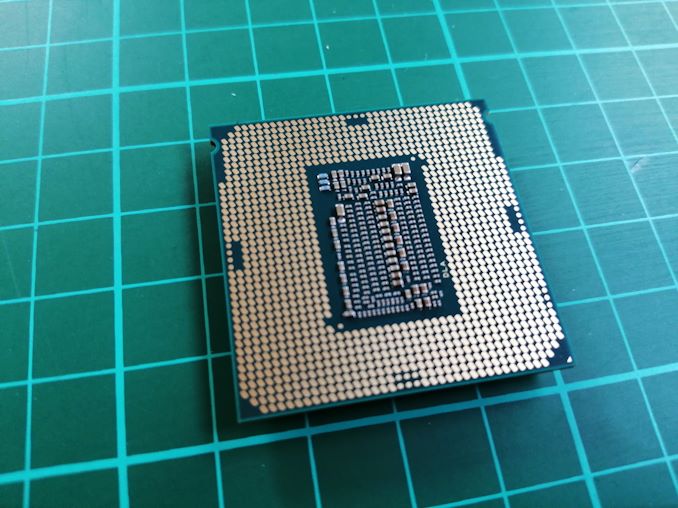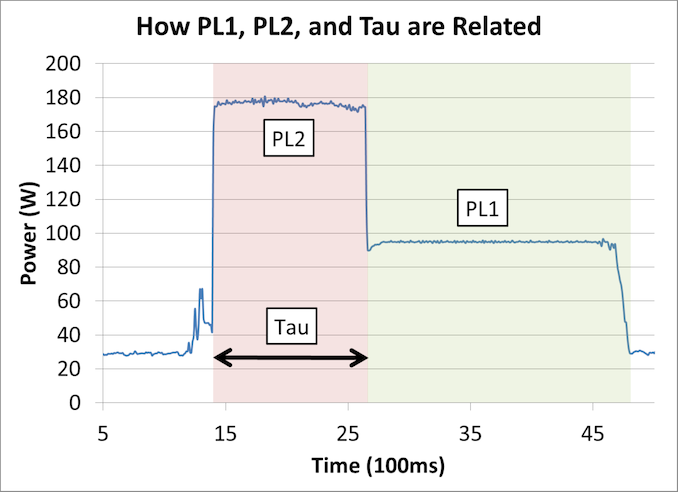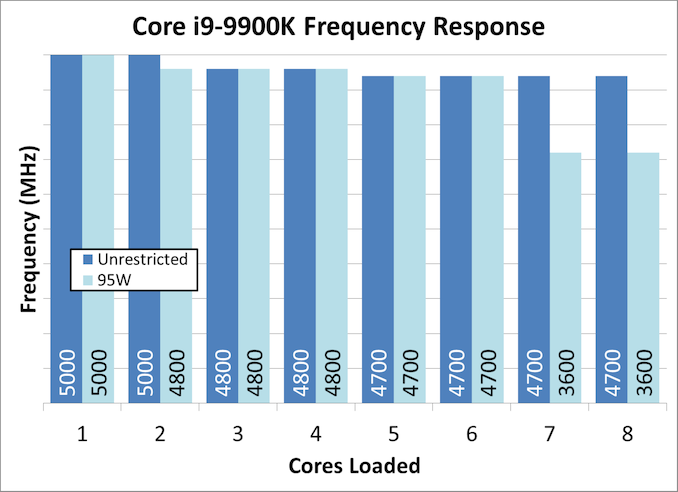The Intel Core i9-9900K at 95W: Fixing The Power for SFF
by Ian Cutress on November 29, 2018 8:00 AM EST
There is a lot of discussion about processor power recently. A lot of the issues stem around what exactly that TDP rating means on the box, and if it relates to anything in the real world. A summary of Intel’s official declaration boils down to TDP as the sustained processor power at long periods, however almost zero motherboards follow that guideline. As a result users will usually see much higher sustained power, although with much higher performance. Some small form factor systems rely on setting these limits, so we tested a Core i9-9900K with a 95W limit to see what would happen.
Intel and TDP
We recently published a sizeable analysis on what Intel officially means by TDP, and the associated values of PL1, PL2, and Tau. You can read it all here, although what it boils down to is this diagram:
When a processor is initially loaded, it should enter a state where PL2 describes the maximum power for a time of Tau seconds. When in this PL2 state, the CPU follows Intel’s per-core Turbo table rules, which reduces the frequency based on the number of cores loaded.
After Tau seconds, the CPU should drop down to a PL1 maximum sustained power value, which is usually identical to TDP. Depending on the CPU, this may reduce the frequency to the base frequency, or well below the all-core turbo frequency.
Technically PL2 is obtained over a moving average window, Tau, such that any low power moments on the processor will 'give budget back' to the turbo mode, however the graph above is the easiest way to see the high turbo mode on a fully loaded processor.
So while Intel defines a value for PL1, PL2, and Tau, almost zero consumer motherboard manufacturers actually follow it. There are many reasons why, mostly relating to overengineering the motherboards and wanting users to have the best performance at all times. The only times where these values follow any form of Intel guidance is in small form factor PCs.
For example, I tested an MSI Vortex G3 small form factor desktop at an event last year. It was using a processor normally rated for 65W TDP, and in a normal desktop that processor would push over 100W because the motherboard manufacturer in that system did not put any limits on the power, allowing the power to fall within Intel’s per-core turbo values. However, in this Vortex system, because of the limited thermal capabilities, the BIOS was set to run at 65W the whole time. This made sense for this form factor, but it meant that anyone looking for benchmarks of the processor would be misled – the power profile set in the BIOS was in no-way related to how that CPU would run in a standard desktop.
A Core i9-9900K with a 95W Limit
To put this into perspective, for this review we are using a Core i9-9900K which has a sustained TDP rating of 95W. When we compare the per-core frequencies of a 95W limited scenario and a normal ‘unrestricted scenario’, we get the following:
When a single core is loaded, the CPU is in 5.0 GHz mode as we are well under the power limit. There’s a slight decrease of 200 MHz in the 95W at two cores, but this disappears when 3-6 cores are loaded, with both setups being equal. The major difference happens however when we are at 7-8 cores loaded: because of the power consumption, the Core i9-9900K in 95W mode drops down to 3.6 GHz, which happens to be its base frequency.
This arguably means that we should see a correlation in most benchmarks between the two parts, but not if maximum load is ever required.
This Review
For this review, we’re putting the Core i9-9900K at a 95W power limit (as measured by the internal registers of the system) and running through our CPU test suite to see if how large the performance deficit is between the Core i9-9900K in a thermally unlimited scenario compared to a small form factor system deployment.
Pages In This Review
- Analysis and Competition
- Test Bed and Setup
- 2018 and 2019 Benchmark Suite: Spectre and Meltdown Hardened
- CPU Performance: System Tests
- CPU Performance: Rendering Tests
- CPU Performance: Office Tests
- CPU Performance: Encoding Tests
- CPU Performance: Legacy Tests
- Conclusions and Final Words












101 Comments
View All Comments
GreenReaper - Saturday, December 1, 2018 - link
I'm not so sure it's as big a win in most cases as it's cracked up to be, especially now that new security measures are required to prevent threads on the same core from being able to use Spectre-class attacks to divulge secrets from timing based on data accessed by other thread.stux - Thursday, November 29, 2018 - link
Apparently a post with an ‘at mark’ in it is spam...Harry_Wild - Thursday, November 29, 2018 - link
I thinking about replacing my proprietary Lenovo Thinkstation P300 motherboard. It is so limited and Lenovo does not update their PC BIOS like other manufacturers to keep the PC up to date with new hardware. Lenovo answer is to buy a new Lenovo PC! Just have to find a new one about the same size and I will jerry rig it in.bairlangga - Thursday, November 29, 2018 - link
So, basically with the power limit in place an 8C-16T i9-9900k is an 8C-16T i7-7820x in a different tshirt riding a different cars, being uncapped is like giving it the pass to run on the autobahn.While we've know that Ryzen 1800x had blown the 7820x out of the water. No more IPC increment for Intel, it seems.
SanX - Thursday, November 29, 2018 - link
IanThe most amazing thing you have revealed in your benchmarks over few last months was the crazy speedup of avx512 on 3D Particle movement which put all recent HEDT incarnations both from Intel and AMD deep into the mud. And in this paper you removed this test. Where is 7900x in the second plot? Or your test was buggy showing these crazy 5x improvements even 7th gen over 9th gen when avx512 was on?
HollyDOL - Friday, November 30, 2018 - link
That would be interesting to see. While AVX can do wonders if the workload is suitable, it IS power hungry. I guess you would still end up with better performance ("tasks per kWh") even with the power limit, but hard to say by how much.I can see on my 8700 how much power at wall and core temp rises when it gets loaded with something AVX heavy.
xTRICKYxx - Friday, November 30, 2018 - link
Once the 9900k is at 95w, the 2700X is looking far more competitive.sharath.naik - Friday, November 30, 2018 - link
You missed come nebench scoresDeath666Angel - Friday, November 30, 2018 - link
Wouldn't mind some tuned undervolted tests for the top consumer processors out right now. :)Consumer1 - Friday, November 30, 2018 - link
Would you be so kind as to change the price of the 9900K in your graphs to the list prices for which it can actually be bought at Amazon and Newegg? Those prices are $579 and $569 respectively when not on sale. It is deceptive to keep listing it at $488.